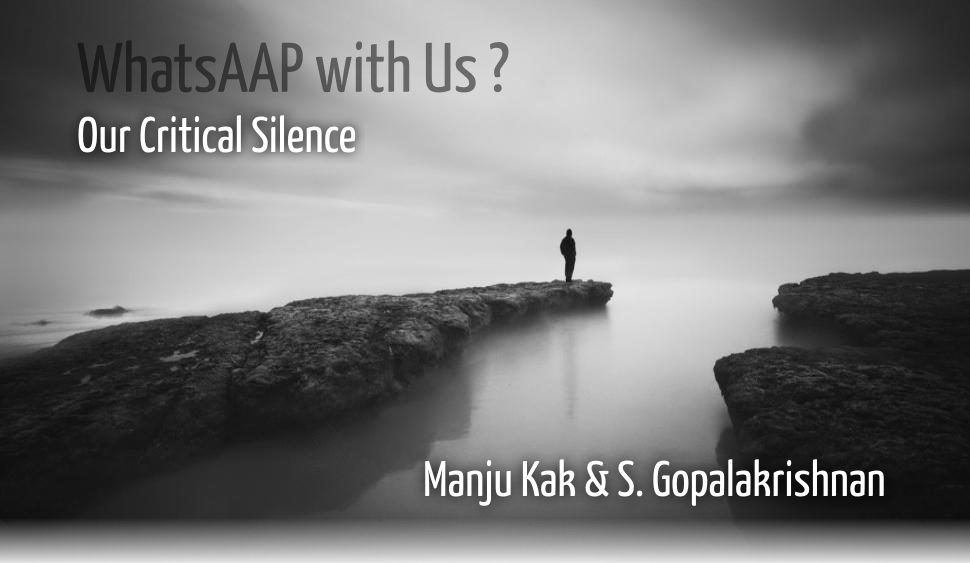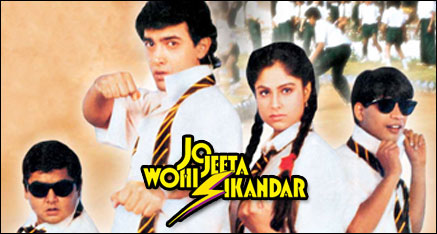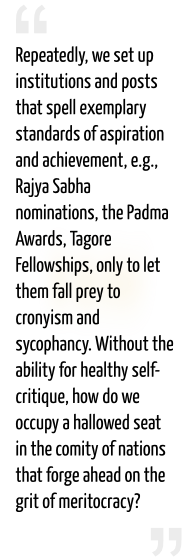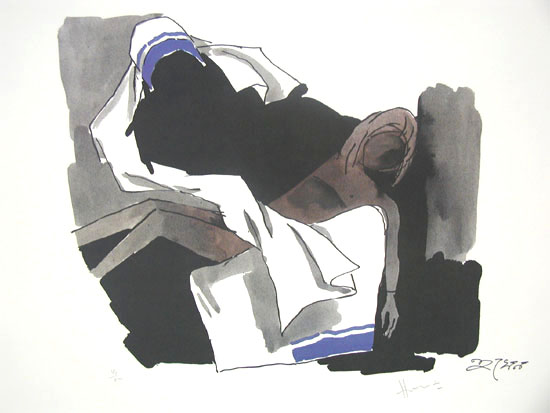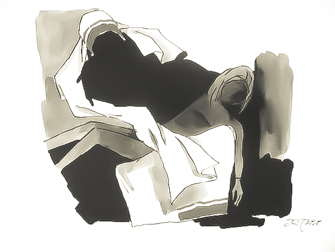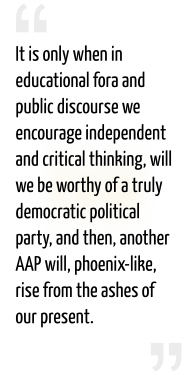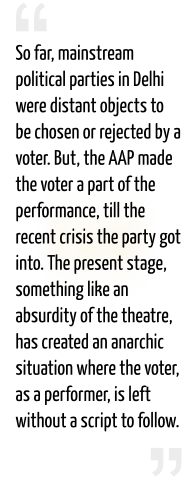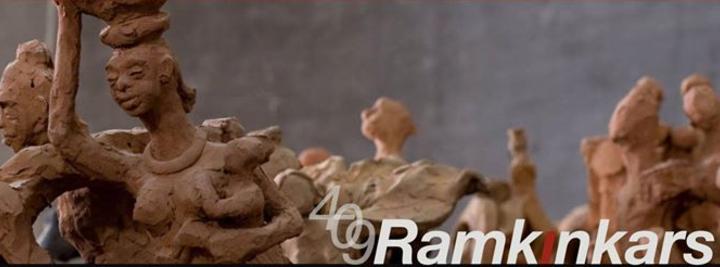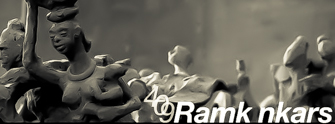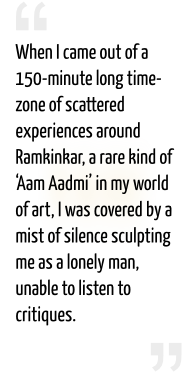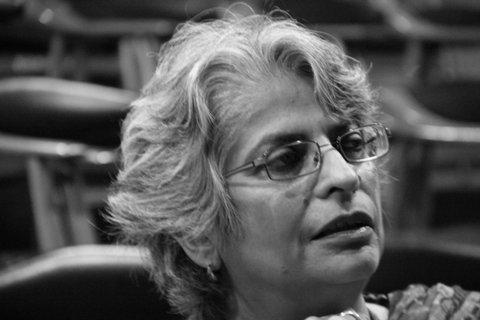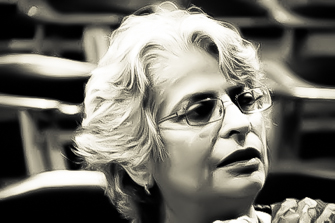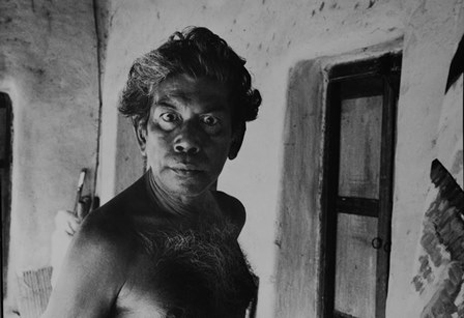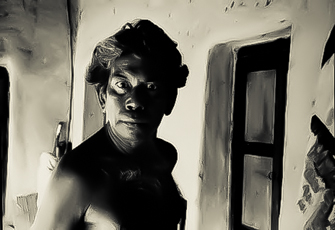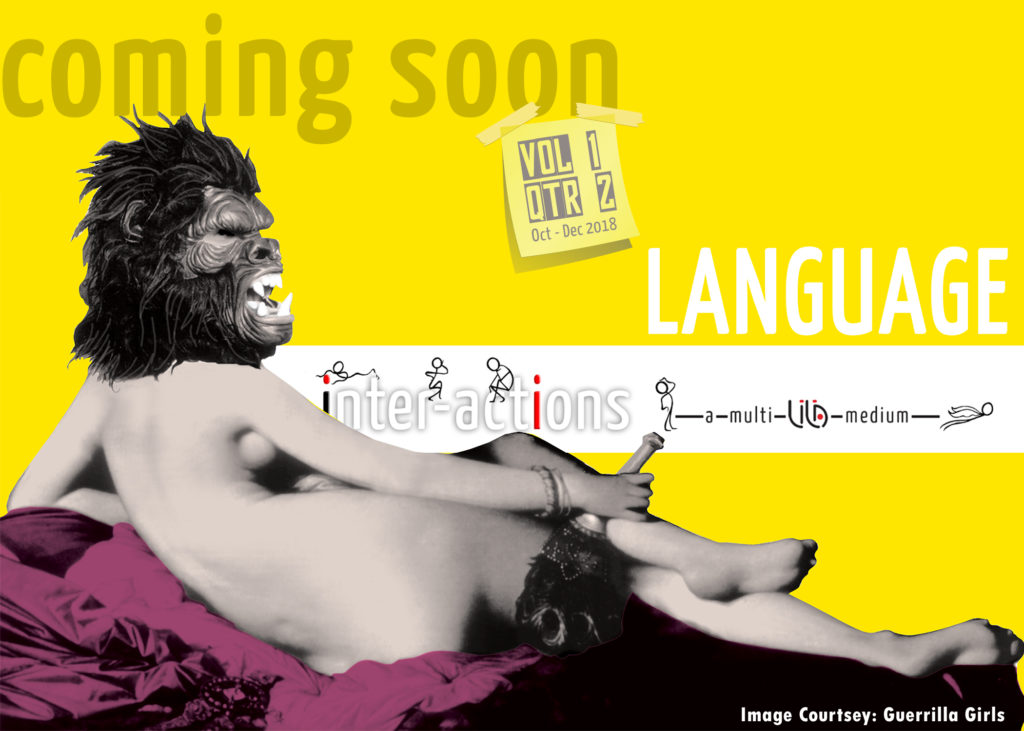

10 April 2015Today, we celebrate I’m Sorry, I Haven’t a Clue. Irony, what the BBC comedy panel game had mocked at, decades back, is staring us, here and now, in the face — the lack of vigilance and critical response to experiences. April is indeed the “cruellest month” — it thoughtlessly sprouts such remembrances of things past in our hard times. In Delhi, we are trying to come to terms with our own decision to forget, forgive and give one more chance to the Aam Aadmi Party, once a symbol of Gandhian aspirations and currently mutating into a polemical space. The recent crisis in the ruling party has left Dilliwallas quite perplexed, and asking: What’s AAP now? This dilemma has prompted LILA to revisit our own ideal of the Citizen Politician, while reviewing Delhi’s current politico-cultural experiences and circumstances. Thus, this edition of LILA Inter-actions uses the unexpected prism of response, rather than venturing to address the crisis directly. The citizen politician in us stops to ask what critical role our responses as individuals play, in defining the quality of our collective experiences and circumstances. We thus enter this inquiry through the responsive window of critical writing, which weaves political engagement into a textual mode of public presentation/performance/production that is also potentially self-reflexive and self-critical. This week, Manju Kak and S. Gopalakrishnan respond to the question: How do we shape our responses? As writers and critical thinkers, they reflect on critical response and self-reflect, and ask if it is our silence that encourages bad governance in various fields, thus degrading our own cultural and political experiences. They make us wonder where the balance of creativity tilts and begins to celebrate lawlessness and showmanship, and where the balance of governance leans to let its machines turn into monsters? They ask: What’s up with us — why are we silent at this critical juncture? They ask: Do we still want to continue celebrating “I’m sorry, I haven’t a clue”?Debate Hold the cursor on the illustrations to display animations. |
|||||||||
Niyat ki BaatManju Kak |
Riding My Two Horses At OnceS. Gopalakrishnan |
||||||||
|
|
|
||||||||
|
Jo Jeeta voh Sikandar — the title of an old Hindi film — seems an apt way to describe the shenanigans of the Aam Aadmi Party — and for the moment, Sikander is Kejriwal and Co. They have ably ousted the troubling Bhushan-Yadav duo. My, that is a putsch! It even smells faintly of the Night of Long Knives (1933 — when Hitler decapitated the Brownshirts, the guys who had propelled him into power). But to those of us who have watched the IAC campaign metamorphose into a political entity called the Aam Aadmi Party, this is truly a questioning moment. No one can doubt that the IAC was a genuine People’s Movement to begin with. But three years after, even Kejriwal’s apologists will agree that he has assumed the title of Supremo in a rather Caesarian political style, in which democracy played a scant part. He held the mace firmly and smacked the opposition out like one would swat a mosquito. AAP: back to Jo Jeeta voh Sikandar
I do not wish to debate the pros and cons of the two (or more?) camps, but, instead, would explore a fundamental question that comes up here: Do us Indians, as a people, lack the ability to look at ourselves critically, an ability that forms the cornerstone of democratic thinking? Do we really understand democracy, or was it just a convenient tool, a thoroughly useful nomenclature to throw out colonial rule, an ism that justified our desire for self-rule, which often translates into a simplistic ‘majoritarianism wins‘?
As a people, we have shown ourselves to be remarkably undemocratic and herd-like in many ways. Repeatedly, we set up institutions and posts that spell exemplary standards of aspiration and achievement, e.g., Rajya Sabha nominations, the Padma Awards, Tagore Fellowships, only to let them fall prey to cronyism and sycophancy. Without the ability for healthy self-critique, how do we occupy a hallowed seat in the comity of nations that forge ahead on the grit of meritocracy? As a nation, most sadly agree, it does not pay our citizens much to hold up the standards of civilised thought or come up with powerful seeds of ideas that germinate into movements symbolised by slogans like ‘Liberty Equality Fraternity’. There is hardly any reward for bringing them to the fore of discourse, either, be it politics, art or social change. Arts and Politics are supposed to be the standard bearers by which one often evaluates and marks places. For instance, when we say The New Yorker, we truly understand that it communicates a very high cultural standard to a critical mind. In our country, we still have to carve out that space, which sets such benchmarks. Take for example the much-touted works of Hussain. Indeed, browsing through a random 5000 works, one would find a large body of them bearing the stamp of genius, but what about the much vaunted Mother Teresa series? Or, those of late Prime Minister Indira Gandhi? Who amongst us would dare call them mediocre or comment on the plainness of the Hussain mural at the Palam airport? In another instance, take the poetry of the benign late Keshav Malik. Much of it was hoisted upon a less discerning public by cultural czars and patrons. Pity, any critical evaluation of such deigned demigods is taboo in our society. What about the much vaunted Mother Teresa series?…
The AAP’s dilemma seems to be reflecting the same problematic as above. Evidently, self-critique has been dealt a body blow in the present AAP crisis. And one has to agree, whatever be the longevity or fate of the AAP, the issues raised by the Bhushan-Yadav duo will remain relevant — the importance of being an ‘accha admi’ with ‘saaf niyat‘, and putting the concerns of humanity above the quest for self-aggrandisement. That reminds us of the ability the Mahatma had to galvanise a whole nation; it inspires every politician’s dream till today. Perhaps Rahul Gandhi in his own way too was trying to regenerate a corrupt and fractious Congress to return to its roots. Now it is the turn of Modi to appropriate the Mahatma’s rhetoric and reap the rewards, though no one can argue with the logic of a Swacch Bharat. But what separates the Mahatma’s drive from the contemporary political shows above is that it was much more than external — it came from genuine motives and intent. Every action of Gandhi was based on introspection, and intended for common good. It was based on — India of my dreams – I shall work for an India in which the poorest shall feel that is their country, in whose making they have an effective voice, an India in which there shall be no high class and low class of people; an India in which all communities shall live in perfect harmony. There can be no room in such an India for the curse of untouchability, or the curse of intoxicating drinks and drugs. Women will enjoy the same rights as men. We shall be at peace with all the rest of the world. This is the India of my dreams. Gandhi transformed idealism into a daily life practice. And, we had hoped for reverberations of the same when IAC erupted.
Now, can the future AAP differ from any other political outfit? Or will it just provide space for political wannabes who could adjust to the BJP or Congress? We are at a moment in history — come April 14, to test just this — and sadly, the AAP may end up as a ripple rather than become the tsunami we had hoped. It is only when in educational fora and public discourse we encourage independent and critical thinking, will we be worthy of a truly democratic political party, and then, another AAP will, phoenix-like, rise from the ashes of our present. |
Delhi is a permanent theatre space where every citizen lives a role, sometimes many roles with or without her own consent or knowledge. Becoming a part of a stage while being a spectator is a premise where one ceases to exist as a performer or as a spectator in totality. Only in this context can we look at the political crisis through which the Aam Admi Party in Delhi is passing.
So far, participating in an election was a day’s role for a voter in Delhi (with a possible exception of the post-emergency election). She could distance herself from the political system by exercising an acceptance or rejection in a polling booth. That was a moment of glory… that is all. The voter always remained a spectator of the theatre before and after that very act of franchising. So far, mainstream political parties in Delhi were distant objects to be chosen or rejected by a voter. But, the AAP made the voter a part of the performance, till the recent crisis the party got into. The present stage, something like an absurdity of the theatre, has created an anarchic situation where the voter, as a performer, is left without a script to follow. At the same time the voter as spectator has also forgotten her/his language of critique. Have you noticed? There is a silence in Delhi now. 409 Ramkinkars
Searching for a language of critique becomes absurd when you are a part of a performance. Recently, I fell into a silent zone of critique while visiting a presentation titled 409 Ramkinkars at Delhi’s Indira Gandhi National Centre for the Arts. Ramkinkar’s many worlds were becoming an installation-performance where I, a spectator, was becoming a performer as well, even as I encountered my own Ramkinkar. Possibly, the 410th Ramkinkar was the one who came out of me and continues to encounter me even when I write this note a week after watching the performance. Ramkinkar’s worlds of sculpture, painting, music, theatre and, above all, politics were the guiding lights of the Vivadi Theatre Group who presented a unique form of theatre called ‘Immersive Theatre’ to generate an ‘art-meets-theatre’ experience. When I came out of a 150-minute long time-zone of scattered experiences around Ramkinkar, a rare kind of ‘Aam Aadmi’ in my world of art, I was covered by a mist of silence sculpting me as a lonely man, unable to listen to critiques. The silence in Delhi over AAP and the silence in me over 409 Ramkinkars are totally different in character though both of these lack a language to express themselves. Both are silences in real time and space. Both the silences are searching for words to express, but, by being a part of the performance, are unable to find its script. In my 15 years’ stay in Delhi, for the first time, I got my vote transferred from Keralam to Delhi, in order to vote for the newly found anarchy, found better than the sickening structures of the mainstream. Believe me, till this time, I have not said a single sentence to anyone about how Kejeriwal, Yogendra Yadav or Prashant Bhushan have handled one another. The obvious reason for this silence is my inability to find a language to critique. Shifting my vote from Keralam to Delhi was an act of active participation in the performance and as an actor, I am looking for my words post-event. I may be doing a disservice to both the AAP experience and the 409 Ramkinkars experience by trying to see parallels in my responses. The only parallel is my search for words to speak. Anuradha Kapur
When the Ramkinkars performance was over, my mind’s initial response was that I like the Anuradha Kapur Theatre part in the show while keeping a distance with the earlier part – installations of sound, body, lights, sculptures, memories and spectators as performers. Though the show was conceived as one entity, I was more comfortable with the theatre aspect, and as a friend of mine partially accused, but partially appreciated, “you are more conventional and hence, you go on liking a conventional piece in the entire experience”. Possibly true. Titled 409 Ramkinkars, the presentation has brought together Anuradha Kapur, Vivan Sundaram, Santanu Bose, Rimli Bhattacharya and Aditee Biswas, and their determined effort of two years made the show possible. Though on the day of the show my ‘conventional’ mind divided the aesthetic experience into three or more parts, let me admit that as days passed on, my memories about the show started sculpting a singular experience, though it is very far from my own Ramkinkar, the 410th one. “I ride both horses at the same time”
When, once, Ramkinkar was asked about his preferences over painting and sculpture, the reply was: “I ride both horses at the same time”. The metaphor of riding two horses at a time only helps me to think about riding on my two silences over AAP and 409 Ramkinkars at the same time. Though we might not fall from a metaphor, I am certain about the fall when it comes to the search for a language of critique on the political or aesthetic experiences of our modern times. When I shared this piece with a friend, he asked, “at least tell me: did you like the Ramkinkars show?” I replied “I don’t know how to answer”. |
||||||||
|
Manju Kak is a fiction writer, critic, an art and cultural archivist and a women’s activist. Her published works of short fiction include First Light in Colonelpura; Requiem for an Unsung Revolutionary (1989), and Just One Life and other Stories (1996) and her A socio-cultural history Uttarakhand: In the Shadow of Nanda Devi is forthcoming. Manju has a PhD in the History of Art, and her latest ethnographic and curatorial work include Nicholas Roerich: A Pact for Peace (2009) and Kashmiri Pandits: A Community in Exile — a Vintage Album (2013). She serves as Honorary Member in Charge (National & International NGO’s) with the All India Women’s Conference (AIWC) which works for women’s rights.
|
S. Gopalakrishnan, Project Director (Content) at Sahapedia, has worked as a music archivist with India’s public broadcaster All India Radio as well as in the field of music documentation and dissemination. He also brings long years of experience in programme management in FM radio and digital media. A post graduate in Philosophy and Gandhian Studies, he is a well-known Malayalam columnist, author of three books and a Sahitya Academy award winner. He has translated Khushwant Singh’s novel The Train to Pakistan into Malayalam.
|
||||||||
Disclaimers: The opinions expressed by the writers are their own. They do not represent their institutions’ view.
LILA Inter-actions will not be responsible for the views presented.
The images and the videos used are only intended to provide multiple perspectives on the fields under discussion.
Images and videos courtesy: Pix Good | Jagprem | Paddle 8 | Time Out | The Hindu | Tumblr
Voice courtesy: Samuel Buchoul & Shriyam Gupta
Share this debate… |
… follow LILA… |
||||
